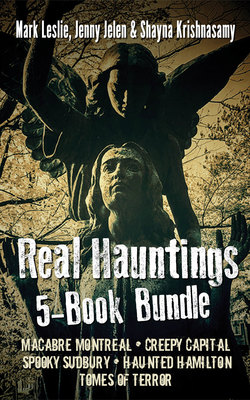Читать книгу Real Hauntings 5-Book Bundle - Mark Leslie - Страница 38
На сайте Литреса книга снята с продажи.
One Town, Two Poltergeists Hudson, Quebec
ОглавлениеPoltergeists never take credit for their mischief. They work in the quiet, when everyone is out of the room. They move your things around, empty your drawers, break the glass in your picture frames. They are the creak in your floorboards as a chair rocks when nobody is rocking it. They are your bedroom door slamming shut on a windless day. They are here, but you never see them. You see only the mess they leave behind.
In the early 1880s, the town of Hudson, just west of Montreal, was disturbed by two poltergeists, as described by John Robert Colombo in Ghost Stories of Canada. The first struck at the Hudson Hotel in October 1880. John Park, the innkeeper, entered a vacant room to find it had been ransacked. All the furniture had been scattered about, including the mattress and the tables and chairs. Weirdly, some pillows had been tied together in such a way that it looked as though a person was sitting there. The windows were all open.
These strange happenings continued for several days. A loaf of bread went missing from the kitchen when the cook left the room briefly. More rooms were left a mess when no one had been there. A fire broke out in the stables. Untouched bottles of booze began to move around in the tavern. The mayhem came to an end rather anticlimactically when a priest performed an exorcism of the building and sprinkled some holy water. There were no further disturbances. All was quiet in the town of Hudson, until it wasn’t.
A year later, in May 1881, the Perrault home was rocked with a series of odd disturbances that couldn’t be explained by the residents, including Madame Perrault, her five children, her mother, and her grandmother. The disturbances consisted mainly of the quiet shuffling around of objects in the home: a lady’s shawl moved, cupboards opened and their contents scattered, furniture toppled. Sometimes it seemed that the poltergeist had a woman’s sensibility, because it kept laying things out neatly: a Sunday dress, a roll of lace, winding sheets. Other times there seemed to be some meaning to the disorder, even though that meaning sometimes couldn’t be discerned, as when twelve porcelain religious figures were found lying in a circle with their heads all pointed together, as if to make a wheel. Or when two pillows were laid out on a bed and a quilt carefully laid over them, making the pillows look like a covered corpse.
No one ever heard a thing, and they couldn’t figure out why any of the events were taking place. Madame Perrault believed that her husband, who was working in Rivière-du-Loup, had passed away and his spirit was haunting them. But her husband was not dead. Then, thirteen-year-old Ernestine, one of Madame Perrault’s daughters, began to have convulsions (or “fits”) so violent that two grown men could barely hold her down. During one hour-long fit she punched through a pane of glass without cutting her skin. She remembered nothing that had happened during the convulsion once it was over.
A priest was called, and he decided to do a little experiment to see for himself if the stories were true. Herding everyone out of the house, he made sure one room was clean and tidy, then closed the door to be sure no one could get in. A little while later, when he returned to check, the room was a mess.
We can’t be sure how things turned out for the Perrault family. No further reports can be found about their home and its poltergeist, though Colombo does put forth one theory that could explain what happened. In the village it was widely known and believed that a curse had been placed on the Perrault family by an old woman. It seemed her husband was owed four dollars for some work he had done for Mr. Perrault, and since he was never paid, the old woman had cursed the house. The villagers seemed unconcerned, asserting that it could have been much worse than furniture being overturned. They believed the old woman could summon Satan.
What happened to the Hudson poltergeist? Were there one or two? Were they banished by the will of the local priest, or did the Perrault family finally pay their debt? We may never know. A poltergeist tells no tales. It simply knocks over your chairs, plays your piano, and locks you out of the house before whisking itself away, leaving you scratching your head, in this case for centuries to come.
